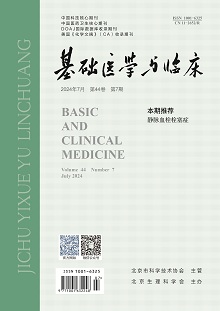Edaravone reduces oxidative stress and inflammation in COPD rats
CHENG Tao, MA Cheng-yuan, YIN Ya-nan, SUN Bei-bei
2021, 41(10):
1457-1462.
 Asbtract
(
196 )
Asbtract
(
196 )
 PDF (2359KB)
(
143
)
References |
Related Articles |
Metrics
PDF (2359KB)
(
143
)
References |
Related Articles |
Metrics
Objective To explore the mechanism of edaravone (EDA) on oxidative stress and inflammation in chronic obstructive pulmonary disease (COPD) rats. Methods The rats were randomly divided into control group, model group, EDA high dose group, EDA medium dose group and EDA low dose group, with 10 rats in each group. The COPD model was developed by intratracheal infusion of lipopolysaccharide (LPS) combined with smoking, and rats were injected intra-peritoneally with 40, 20, and 10 mg/kg EDA. Twenty-eight days after modeling, the pulmonary function and the wet-to-dry weight ratio (W/D) of the lung tissues were examined. ELISA method was used to detect the level of SOD, MDA, TNF-α, IL-1β and IL-6 in lung tissues. The pathological changes of lung tissues were microscopied with HE staining. Western blot was used to detect the protein expression of Caspase-3, MMP-9, TLR4, MyD88, NF-κB p65 protein expression and IκBα phosphorylation. Results Compared with control group, the resting breathing frequency and airway resistance (RI) of model group increased, the values of peak inhale flow(PIF) and dynamic lung compliance (Cdyn) decreased; the lung injury was obvious, the SOD activity of the lung tissues decreased, the contents of MDA, TNF-α, IL-1β, and IL-6 increased, and Caspase-3. MMP-9, TLR4, MyD88 expression and IκBα phosphorylation increased, and NF-κB p65 intranuclear metastasis was obvious(P<0.05). Compared with model group, EDA reduced resting respiratory frequency, RI, increased PIF and Cdyn, reduced lung injury, increased SOD activity of lung tissues, reduced MDA, TNF-α, IL-1β, IL-6 contents, and reduced caspase-3, MMP-9, TLR4, MyD88 expression and IκBα phosphorylation, NF-κB p65 nuclear metastasis was restricted (P<0.05). Conclusions EDA can improve the lung function of COPD rats, reduce lung tissues damage, inflammation and oxidative stress.


